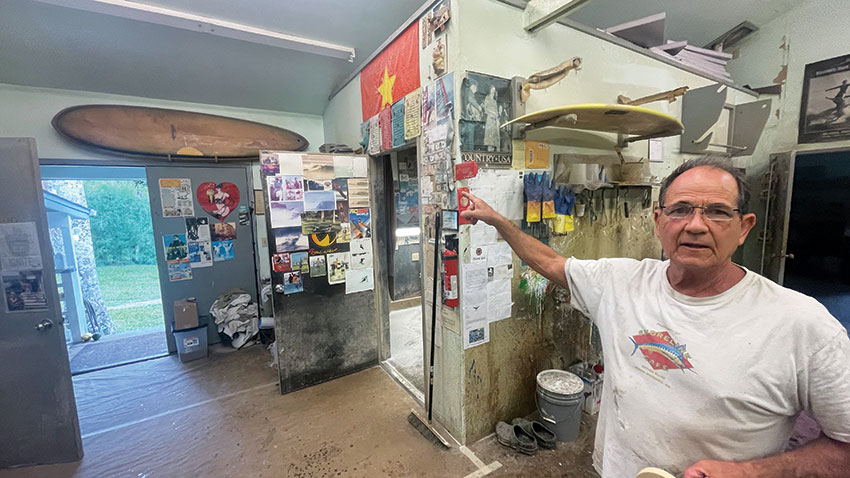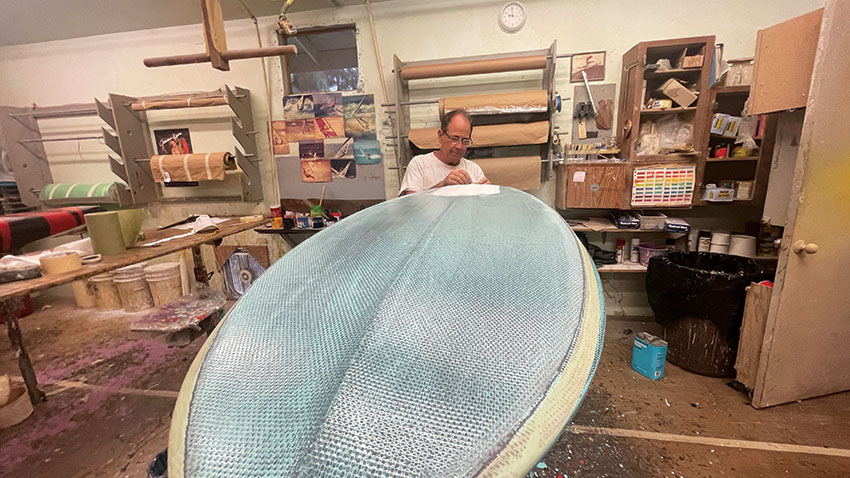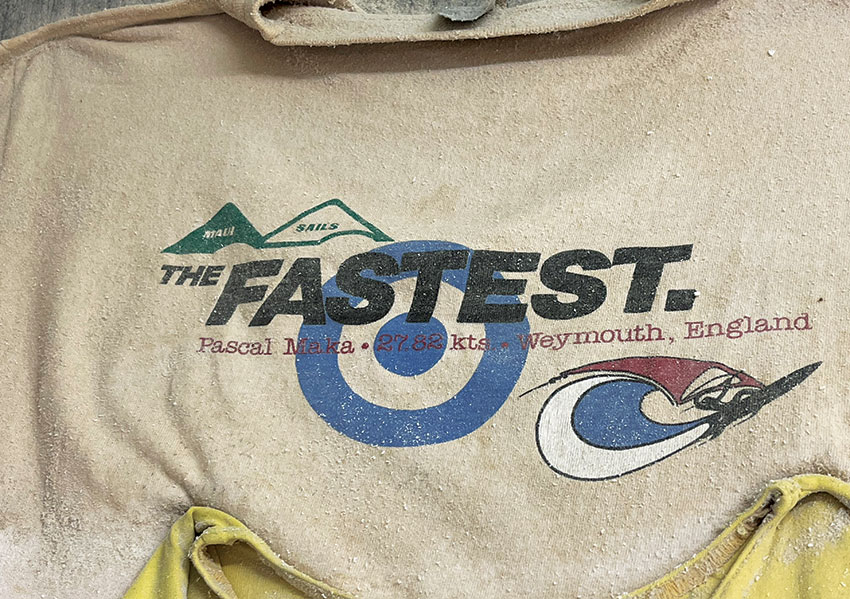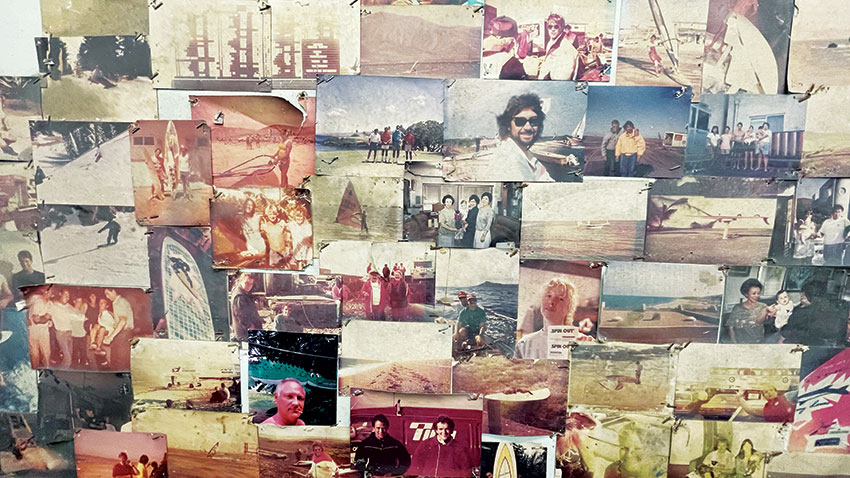Published in Stand Up Magazin #23
Text: Mike Jucker
Photos: Jimmy Lewis and Friends
It’s a privilege to meet, interview and tell the stories of so many different people with Stand Up Magazine. The number of people we have written about over the last twelve years is not in my head, nor does it matter. What does matter is how different these people are and yet they all have something in common: a passion for water sports. Some of them are young and full of dreams, others are in the middle of their lives and still others can look back on an eventful past at their age. One such person is Jimmy Lewis. Jimmy has been a board shaper for longer than most of us have been alive. Jimmy Lewis’ eponymous brand and logo is well known. So well known, in fact, that others have copied it and even used the name in a modified form. The year is 2023 as I sit with Jimmy on the stairs of his workshop and he tells me his story, which began in the 1960s:
“I grew up in southern California in the sixties. My older brother and I listened to the “surf music” that was just becoming popular on the radio. I was about twelve or thirteen years old and we loved this music. My brother then wanted to start surfing and of course I did straight away. I was in 6th grade and had to do what my brother was doing. I still remember how we went to the beach with my mother during the summer vacation between 6th and 7th grade. There was a “surf store” with a shaper. I took some of his scraps home with me and made a mini surfboard out of the remaining foam. Then I cut the surf logos out of magazines and laminated them onto my mini boards and thought that was the greatest thing.
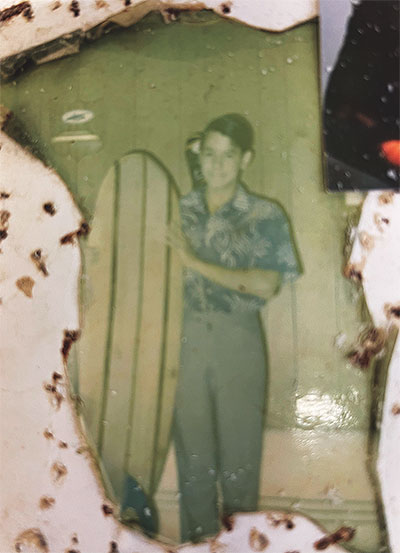
When I was in 7th grade, I wanted to make a real board out of wood. Back then, we had small boards that you could ride on your stomach. So I really wanted to make one of those “bellyboards”. But the teacher in the shop class said it was far too big a project and I would have to wait until year 9. Waiting two years until I was allowed to do it was an eternity and I still remember that for two years I couldn’t think about anything else but finally getting to year 9, being able to make myself a board and go surfing with it. Of course, we were already surfing before that. I finally got to year 9 and was able to make this board. However, work lessons weren’t every day, so it took from the summer until the Christmas vacations until the board was finally finished. I could hardly wait to go into the water with it.
But the teacher told me to show the class how to finish the board. That was very annoying, because the carpentry lessons weren’t every day and that would delay my project even further. What’s more, the school carpentry workshop is not suitable for working with epoxy and fiberglass. So I hid the board behind the door and on the Friday before the vacations started, I simply took the board home with me.
The teacher didn’t like it at all and failed me in class. I always got top marks in handicrafts, but this board earned me an “F” for fail. But my goal was more important to me: the board had to be finished by Christmas so that I could get into the water.
In 1967, we moved north to Berkley, where my mother went to university. I thought my surfing days were over. I just knew it was very cold in Northern California and thought there were icebergs in the water. After about six months, my brother came to visit, we went to Santa Cruz and went surfing. I was very surprised! It was cold, but not nearly as cold as I thought it would be. I then met other kids at high school who surfed. We often went to a beach north of San Francisco with them. One day, back in 1968, I saw a homemade surfboard on the beach. It was a short board and I immediately realized that I could build something like it. I grabbed my mother’s car and drove to Santa Cruz to O’Neill (they also had surfboards back then). I bought a “blank”, resin and fiberglass there and went back home to make my first real surfboard. That led to me making a few boards for my colleagues. I graduated from high school in 1969. My brother was already on Maui and I really wanted to go there too. My colleague Tony wanted to come with me, so we worked all summer to save money for the trip. So after the summer we went to Maui. But life there wasn’t very easy. I was 18 years old and away from home for the first time. I barely made it three months and then went back home to my mom in Berkley. I made myself a new board, stayed with her for two months and then moved to Santa Cruz, where I set up a “shape room” in the bedroom of a house.
In the spring of 1971, I was ready to make another attempt on Maui. I was older now and had been away from home for over a year. I knew what to expect on Maui and was a lot better prepared. I had a few jobs at surf stores and lived on the west side in Lahaina for four years. I kept my head above water there as a waiter and painter. But the priority was making surfboards and of course being in the water as much as possible.
Like so many surfers, we were very unreliable. I mean, we worked to keep our heads above water, but our priorities were surfing. A good story comes to mind:
My friend and I, he was even more unreliable than me… so one summer we were surfing in Lahaina after a very long time without waves. We were literally craving waves. But as waiters, we knew we had to show up at work at 3pm to set the tables. It was time to go, but we told ourselves we still had time for a wave. That turned out to be the case: It’s not so bad if we’re a bit late. So we surfed for a while and then just decided to call in sick for the day. Even before we paddled back to shore, we said to ourselves: “Fuck it, we’ll just quit.” All within one surf session! From “we’ll be late” to “fuck it, we’re not going to work at all.” That was the surfing life on Maui.
At the end of the seventies, windsurfing was really popular. There was Mike Walze and Fred Haywood, who were out on Hoyle Schweitzer’s boards and they had the idea of founding “Sailboards Maui”. Mike was here a lot and discovered how good Ho’okipa was for windsurfing. Anyway… in 1979 I was working in a surf store called Mana Surfboards. One day Mike Walze came to the store with his colleague and wanted a custom windsurf board. The store owner was also a shaper, but for some reason he let me make the board for Mike. That was the moment when I thought that I could earn my living with windsurf boards. Making surfboards was always something I did on the side and I wasn’t very serious. I could have made money with it much earlier, but as I said, I wasn’t serious enough. Most of the people I made a board for charged me 10 dollars. I thought that was the only way they would come to me and I just liked the work so much. So Mike Walze and Fred Haywood started their company, Sailboards Maui. Fred’s family had a house in Kahului from where they set up store. I myself lived in Kihei and built a shape room. But the landlord didn’t like that and told me I had to take everything down. Fred and Mike were kind enough to offer me the chance to install my shape room in their house.
Later, a guy from the mainland who worked for Hoyle (Schweitzer) arrived. He wanted some shorter boards that he wanted me to make for him. It was a 9′ foot board and an 8′ foot board in two different shapes. That became the Rocket 99 and the Rocket 88, and there were a few windsurfing races at the time. The PanAm Cup on Oahu was the biggest event there was. Robby Naish was still a kid and amazed the world with his talent. Then someone came along and brought a windsurfing race to Maui. I think it was called the “Grand Prix” and it later became the ALOHA Classic. Mike and Fred organized it, if I remember correctly. A lot of people came here and everyone saw how much better Maui was for windsurfing than Oahu. So Maui became the epicenter of the windsurfing world. I was the guy for Sailboards Maui who made all the custom boards for the brand. That made me and my work known all over the world.
During this time – and even a few years before – Dick Brewer was one of the most influential shapers in the industry. Dick Brewer had a concave dent shaped into the back of the tail of all his boards. I’m not quite sure what it did, but it was definitely a big feature of his boards. One day I was at work and accidentally sunk my grind block into the foam of the board. I thought “What the fuck am I going to do? To save the board, I also sanded a concave dent into my board.
Anyway… so that was my board, which I thought it became unsellable. At some point, Pascal Maka came to Maui and also to the Sailboards Maui store.
Info: Frenchman Pascal Maka is one of the most influential and best windsurfers of his time. Pascal Maka broke the world sailing record in 1986 with 38.86 knots. It was the fastest speed ever set by a sail-powered watercraft. Previously, only catamarans had been able to sail that fast.
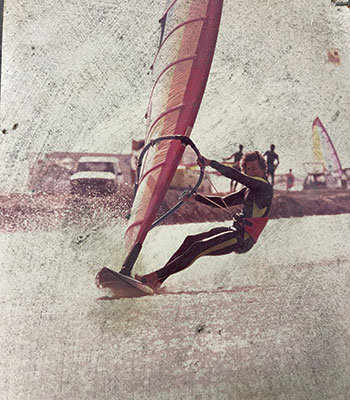
There were speed races around the world at the time, one in England and one in France. Many of us wanted to take part in these races and they became more and more popular. It was about who was the fastest over a distance of 500 meters, powered only by the wind. There was a catamaran called “Crossbow” that held the world record in sailing. All the windsurfers wanted to beat this catamaran. Of course there were different classes, but “Crossbow” held the “absolute” record and everyone wanted to set a new record.
Now Pascal Maka bought this board with my dent and a Maui Sail. He took it to Weymoth in England and sailed 27.82 knots. I still have a T-shirt from it. I’ll show it to you.
It was just incredible, the whole windsurfing world was in an uproar! So you remember Arnaud De Rosnay? He was a Frenchman, first a surfer and then a windsurfer. He made a name for himself with channel crossings. He sailed across several straits and in 1984 he disappeared with his windsurfer between Taiwan and China. He sent me a telex when Pascal set the new absolute sailing speed record on my board.
Now everyone was interested in speed sailing. That was in 1982 and in 1983 Fred Haywood also wanted to go to England for this race. So I built him two special speedboards and changed the concave dent a bit.
Fred went to England and was then even faster than Pascal. Fred managed to sail over 30 knots. Pascal was there too, of course, but he had a new board from a French shaper. Fred left him in the dust. That showed that my boards were the best. After Fred’s victory, my board, still with Sailsboar’s Maui, was on the cover of every windsurfing magazine in the world.
But I already had my logo on my business cards back then and laminated the logo from the business card onto the board in very small letters. Around 1984, Sailsboards Maui was bought out and the factory was already in Paia and no longer in Fred’s family home. The new owner hired a second shaper who was now also supposed to make my shapes. I decided that if someone else did my shapes, I should receive a commission. The new owner wasn’t keen on this idea. He thought I had too big an ego. I didn’t care what he thought and built my own store and shape room in Haiku. Now everything was under my brand and I was producing windsurf boards with the “Shark logo”. Although I had already had the logo since the seventies, the brand became independent. My brand was actually called “Mud Shark” back then – named after a song by Frank Zappa. As a joke, I called my boards “Mud Shark” and my brother drew me the shark.
I was once sued by Levis Jeans in Belgium for my lettering. It cost me 15,000 dollars to prove them wrong. There’s a watch brand in Germany that made their logo very similar, they sponsor the windsurfing speed race in Namibia. People always think it’s me. I don’t mind that. I see it as a compliment.
(Info: In the US the big box store sells foam boards under the name „Jimmy Styles“.)
„I’m going to take a brief pause in the story here, because now the question of how Jimmy Lewis survived the decline of the windsurfing industry is burning inside me.“
I bought land here in 1989. At the same time, my priorities shifted somewhat. I was now a landowner and my son had just been born. When the waves were good, we’d all meet up at Ho’okipa, but when there were no waves, we’d go to Spreckelsville and do laps on our slalom boards. At some point, however, fewer and fewer people came to the beach and doing laps alone was very boring. I got to the point where I wondered whether I should mow the lawn or go to the beach. I decided to mow the lawn. I had enough work, but it’s true: the factory boards became less and I started to lose interest in windsurfing. That was all back in the early nineties. I had this land and built a house on it. I was also able to build my own workshop for making boards. There were three of us and we also made surfboards, but at some point my brother and my employee had to go looking for a job. I started surfing again, but only on longboards and made a few of them.
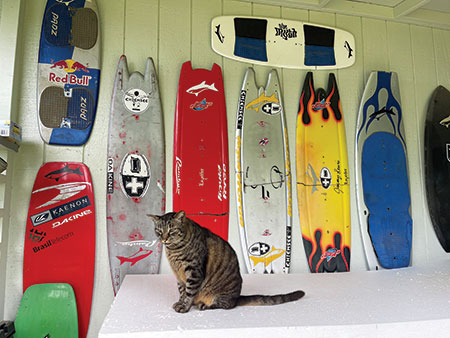
That went well until the end of the nineties, when I met Lou Wainman. Lou was a kiteboarder and I always told people that if they wanted a board of me, they should just say so. So one day Lou came by and asked for a kiteboard, so I made him one. Within a few months he improved his skills and he had lots of ideas on how to design a kiteboard.
I was in the right place at the right time with the right person. We produced a lot of boards and my brother came back to work with me. We made so many kiteboards that I had to contact my factory. I had been in contact with a factory since the eighties thanks to a royalty deal with another windsurfing brand. But the windsurf brand disappeared and I stayed in contact with the factory people. So I contacted them and asked if they could make my boards. I was one of their first customers and had known them for a long time. They accepted my request and started producing my twin-tip kiteboards. One day I was in the factory and saw surfboards from other brands. Then I thought, since I’m already making surfboards, why don’t we try out some “production boards”. I made longboards, minimalibus and also shortboards. A little later, the SUP trend came along and we added SUPs to my collection. From then on, everything just got bigger and my production shifted towards production boards and less custom boards. But that was fine with me. So my brother had to go looking for a job again and the other guy quit because there wasn’t much left to do here.
But I have always shaped boards and will always shape boards. I do everything myself, from shaping to polishing, it’s all me. But I don’t like sandwich boards or vacuum boards any more, I don’t do that anymore. I’m retired now and if someone comes and wants what I do, then I’m happy to do it. But if a customer wants something else, he/she has to go somewhere else. It’s always a compliment when someone comes and wants what you do. But I’m at an age now where I only want to do what I want to do and when I want to do it.
„I am very fascinated by Jimmy’s life story and just listen. However, now that Jimmy is an older gentleman and we are counting down to 2023, I would like to inquire about his wishes for his legacy. Jimmy Lewis’ brand and logo is as well known as other great brands. But unlike the others, it’s still just Jimmy behind it all. No big offices with marketing and sales departments. It’s still Jimmy who pulls all the strings and the man is 72 years old.“
If I were dead tomorrow, the only thing that would make me happy would be if my son Marlon kept the whole thing alive a little longer. I tell him you can continue with my existing shapes for a few more years. But if Marlon doesn’t want that, then so be it. When I’m dead, I’m gone. I don’t look down from a cloud and say: “Oh, why doesn’t anyone buy my boards anymore?” When I’m gone, I’m just… gone. There’s nothing you can do. Sure, the people who still have my boards can’t buy new ones, but I have no control over that anymore. My son can then decide what he wants to do, that’s up to him. I mean, I grew up in the golden age of surfing. Many people don’t even know the big names from that time. Names of people who were my heroes. New generations are coming and my name will also be forgotten at some point. Especially in the times we live in now. Back then we still had photos, now when Jaws breaks we have hundreds of pictures on the internet. Tomorrow the pipeline breaks and people don’t give a shit about what happened at Jaws yesterday. Who’s going to remember me ten years after I’m dead? We live in a time where we’re inundated with news and content. I’m not in the mood for that. I post pictures on social media when there’s something special and not twenty times a day like other people. Generations come and generations go, that’s the way it is and it’s no different for me.
„So I’m sitting with Jimmy on the steps outside his workshop and we’re talking about social media and how times have changed. When I meet people like Jimmy and hear their story, I always deliberately go into a conversation like this unprepared because it makes it so much more exciting. The time with Jimmy flew by. I’m sitting here listening to the story of a boy who only wants one thing in life: to make surfboards. This boy has become a globally recognized brand. Legacy or not, I will definitely have another board shaped by Jimmy so that one day I can say: “Jimmy Lewis made this for me.“

